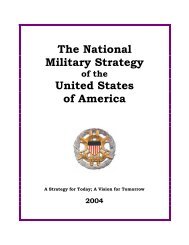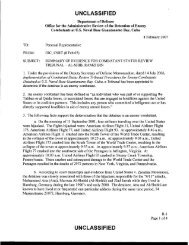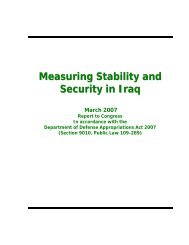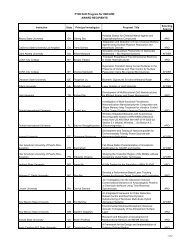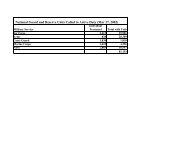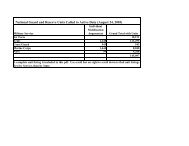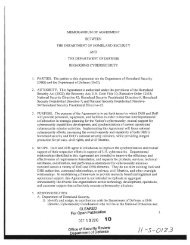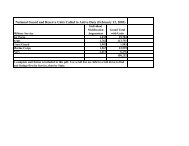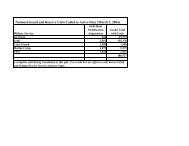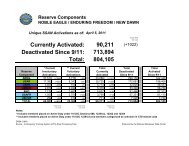Report - United States Department of Defense
Report - United States Department of Defense
Report - United States Department of Defense
You also want an ePaper? Increase the reach of your titles
YUMPU automatically turns print PDFs into web optimized ePapers that Google loves.
UNCLASSIFIED<br />
Transition is On Track<br />
The transition process is on track for completion by the end <strong>of</strong> 2014, with four <strong>of</strong> five tranches <strong>of</strong><br />
provincial districts fully in transition, and the fifth tranche entering transition this summer. 2<br />
President Karzai announced tranche four on December 31, 2012, and all districts in this tranche<br />
began transition by March 2013. With tranche four now underway, approximately 87 percent <strong>of</strong><br />
the Afghan population is living in areas where transition has occurred or is occurring and 23 <strong>of</strong><br />
Afghanistan’s 34 provinces are wholly in transition. Tranche four moved Afghans into the lead<br />
for security in important population centers, economically significant districts and large areas in<br />
the east and center <strong>of</strong> the country. Tranche five was announced this spring and will be<br />
implemented in late summer; it will include all remaining districts in Afghanistan, most <strong>of</strong> which<br />
are along the border with Pakistan. Areas that enter transition undergo several stages <strong>of</strong> progress<br />
that gradually increase Afghan control. Areas that reach the final stage <strong>of</strong> transition remain at<br />
that stage until December 2014 when all provinces and districts in Afghanistan will graduate<br />
from transition, regardless <strong>of</strong> what stage they have achieved.<br />
As U.S. and coalition forces draw down and re-posture, the ANSF is taking the lead in<br />
transitioned areas and helping to expand Afghan government influence, most notably in Regional<br />
Command–North (RC-N), where ISAF forces have substantially reduced their coverage.<br />
Transition is a dynamic and uneven process, with some areas progressing quickly and others<br />
moving slowly or even regressing. Notably, some areas <strong>of</strong> Badakshan Province saw increased<br />
insurgent attacks with the ANSF taking significant casualties, indicating that ISAF will continue<br />
to have to assess the pace and scope <strong>of</strong> transition to prevent premature withdrawal and to learn<br />
appropriate lessons to make the transition process more effective.<br />
Kabul remains the most densely populated and secure area in the country under the ANSF’s<br />
security lead despite consistent insurgent attempts to conduct attacks there. Poor coordination<br />
between the ANA and Afghan Uniform Police (AUP) is a major challenge in transitioned areas.<br />
Attacks along access routes to major population centers as well as government ineffectiveness<br />
also hamper transition. Governance and development continue to be inadequate in many<br />
transitioning areas and will require continued substantial levels <strong>of</strong> assistance from the<br />
international community well into the 2015-2024 “Decade <strong>of</strong> Transformation.”<br />
Mixed Cooperation with Pakistan<br />
Overall, relations between Pakistan and the <strong>United</strong> <strong>States</strong> have stabilized. Although Pakistan<br />
and Afghanistan both acknowledge that stability in Afghanistan impacts Pakistan and vice versa,<br />
relations between the two nations continue to be rocky and dominated by mistrust. Bilateral<br />
visits between Pakistani and Afghan leaders increased during the past year, including recent<br />
high-level visits to Afghanistan by Foreign Minister Khar and Chief <strong>of</strong> Army Staff General<br />
Kayani and by Minister <strong>of</strong> <strong>Defense</strong> Bismillah Khan Mohammadi and Afghan High Peace<br />
Council Chairman Rabbani to Pakistan. In February 2013, during a trilateral meeting in the<br />
<strong>United</strong> Kingdom, President Karzai and President Zadari agreed to strengthen bilateral efforts to<br />
2 In accordance with the 2010 Inteqal (Transition) Framework, which establishes the Afghan-led process, transition will occur in phases based on<br />
the selection <strong>of</strong> five geographic areas, or “tranches.” The first fourhave already entered transition. The fifth tranche began entering transition in<br />
June, 2013.<br />
4



